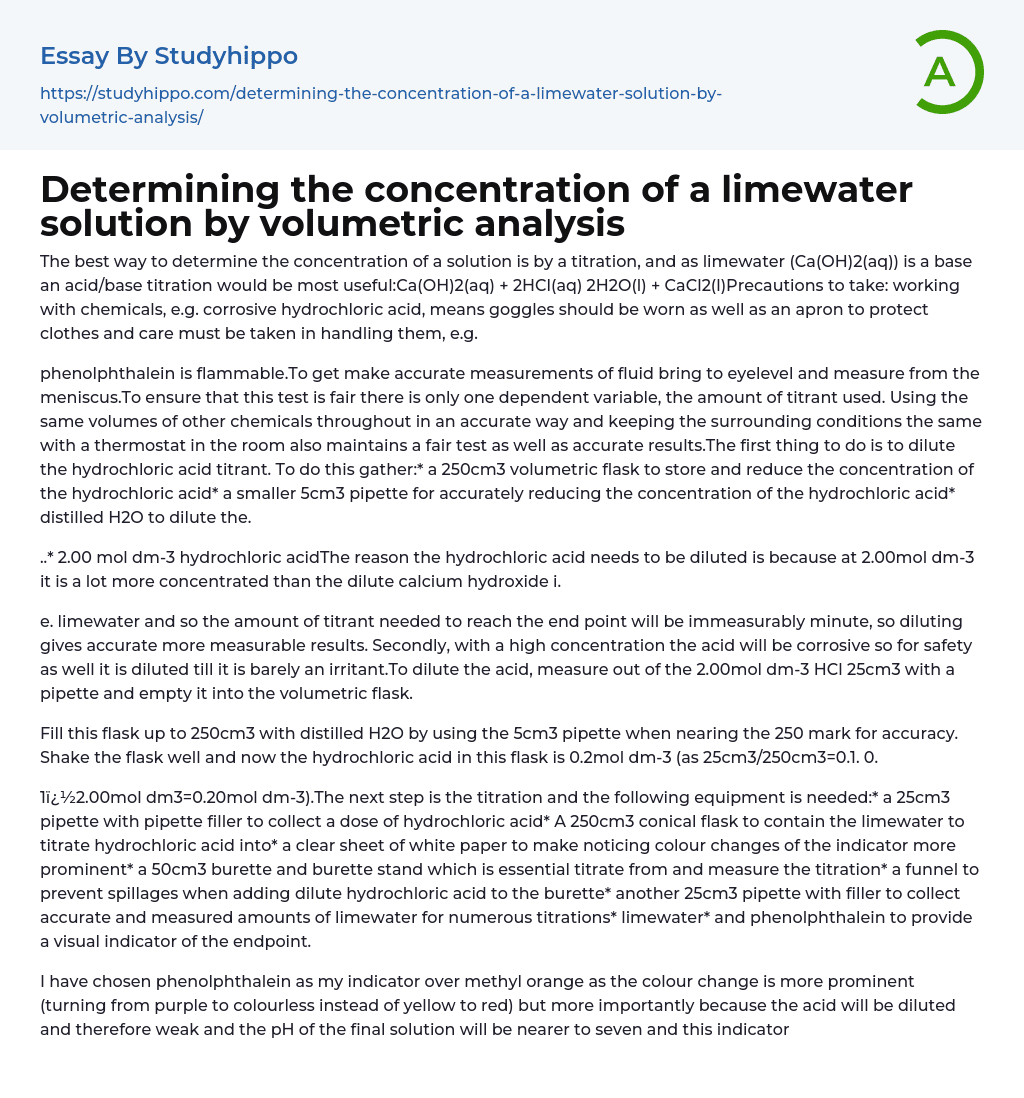

Determining the concentration of a limewater solution by volumetric analysis Essay Example
The best way to determine the concentration of a solution is by a titration, and as limewater (Ca(OH)2(aq)) is a base an acid/base titration would be most useful:Ca(OH)2(aq) + 2HCl(aq) 2H2O(l) + CaCl2(l)Precautions to take: working with chemicals, e.g. corrosive hydrochloric acid, means goggles should be worn as well as an apron to protect clothes and care must be taken in handling them, e.g.
phenolphthalein is flammable.To get make accurate measurements of fluid bring to eyelevel and measure from the meniscus.To ensure that this test is fair there is only one dependent variable, the amount of titrant used. Using the same volumes of other chemicals throughout in an accurate way and keeping the surrounding conditions the same with a thermostat in the room also maintains a fair test as well as accurate results.The first thing
...to do is to dilute the hydrochloric acid titrant. To do this gather:* a 250cm3 volumetric flask to store and reduce the concentration of the hydrochloric acid* a smaller 5cm3 pipette for accurately reducing the concentration of the hydrochloric acid* distilled H2O to dilute the.
..* 2.00 mol dm-3 hydrochloric acidThe reason the hydrochloric acid needs to be diluted is because at 2.00mol dm-3 it is a lot more concentrated than the dilute calcium hydroxide i.
e. limewater and so the amount of titrant needed to reach the end point will be immeasurably minute, so diluting gives accurate more measurable results. Secondly, with a high concentration the acid will be corrosive so for safety as well it is diluted till it is barely an irritant.To dilute the acid, measure out of the 2.00mol dm-3 HCl 25cm3 with a pipette and empty i
into the volumetric flask.
Fill this flask up to 250cm3 with distilled H2O by using the 5cm3 pipette when nearing the 250 mark for accuracy. Shake the flask well and now the hydrochloric acid in this flask is 0.2mol dm-3 (as 25cm3/250cm3=0.1. 0.
1�2.00mol dm3=0.20mol dm-3).The next step is the titration and the following equipment is needed:* a 25cm3 pipette with pipette filler to collect a dose of hydrochloric acid* A 250cm3 conical flask to contain the limewater to titrate hydrochloric acid into* a clear sheet of white paper to make noticing colour changes of the indicator more prominent* a 50cm3 burette and burette stand which is essential titrate from and measure the titration* a funnel to prevent spillages when adding dilute hydrochloric acid to the burette* another 25cm3 pipette with filler to collect accurate and measured amounts of limewater for numerous titrations* limewater* and phenolphthalein to provide a visual indicator of the endpoint.
I have chosen phenolphthalein as my indicator over methyl orange as the colour change is more prominent (turning from purple to colourless instead of yellow to red) but more importantly because the acid will be diluted and therefore weak and the pH of the final solution will be nearer to seven and this indicator has an end point closer to seven2 than methyl orange.Set up the burette to the stand and making sure the tap is closed, fill the burette to the 0.0cm3 mark. Do this using a funnel2 to prevent spillage but remember to remove this funnel afterwards as excess drips could ruin readings if left in the burette and ensure there is no air bubble at the tip of the burette1
that will make it seem there is more acid in the burette than there actually is.Now prepare the limewater; first shake the bottle of the limewater so the calcium hydroxide isn't all sitting at the bottom and then using the clean 25cm3 pipette take 25cm3 of limewater and eject it into the 250cm3 conical flask.
Make sure to have all the contents of the pipette by dipping the tip into the limewater solution. Now add no more than two drops of phenolphthalein into the solution as adding too much may affect the results1 (phenolphthalein is slightly acidic).Place the conical flask under the burette with the end in the flask1 (but not touching the solution) and carefully and slowly release the hydrochloric acid from the tap. Do this while swilling the conical flask to get a quicker colour change and not overshoot the acid.
Start releasing the acid in single drops when the purple solution in the flask begins to turn colourless and when the solution is completely colourless stop adding hydrochloric acid as the endpoint has been reached.Using this first attempt as a test run to get used to the procedure and be able to anticipate when the titration is reaching endpoint, analyse another 25cm3 of limewater by taking where the previous titration finished as the start point. Then repeat the titration again and again until at least three results3 are within 0.1cm3 of each other for reliability.
- Acid essays
- Calcium essays
- Carbohydrate essays
- Carbon essays
- Chemical Bond essays
- Chemical Reaction essays
- Chemical reactions essays
- Chromatography essays
- Concentration essays
- Copper essays
- Diffusion essays
- Ethanol essays
- Hydrogen essays
- Organic Chemistry essays
- Osmosis essays
- Periodic Table essays
- Ph essays
- Salt essays
- Sodium essays
- Titration essays
- John Locke essays
- 9/11 essays
- A Good Teacher essays
- A Healthy Diet essays
- A Modest Proposal essays
- A&P essays
- Academic Achievement essays
- Achievement essays
- Achieving goals essays
- Admission essays
- Advantages And Disadvantages Of Internet essays
- Alcoholic drinks essays
- Ammonia essays
- Analytical essays
- Ancient Olympic Games essays
- APA essays
- Arabian Peninsula essays
- Argument essays
- Argumentative essays
- Art essays
- Atlantic Ocean essays
- Auto-ethnography essays
- Autobiography essays
- Ballad essays
- Batman essays
- Binge Eating essays
- Black Power Movement essays
- Blogger essays
- Body Mass Index essays
- Book I Want a Wife essays



